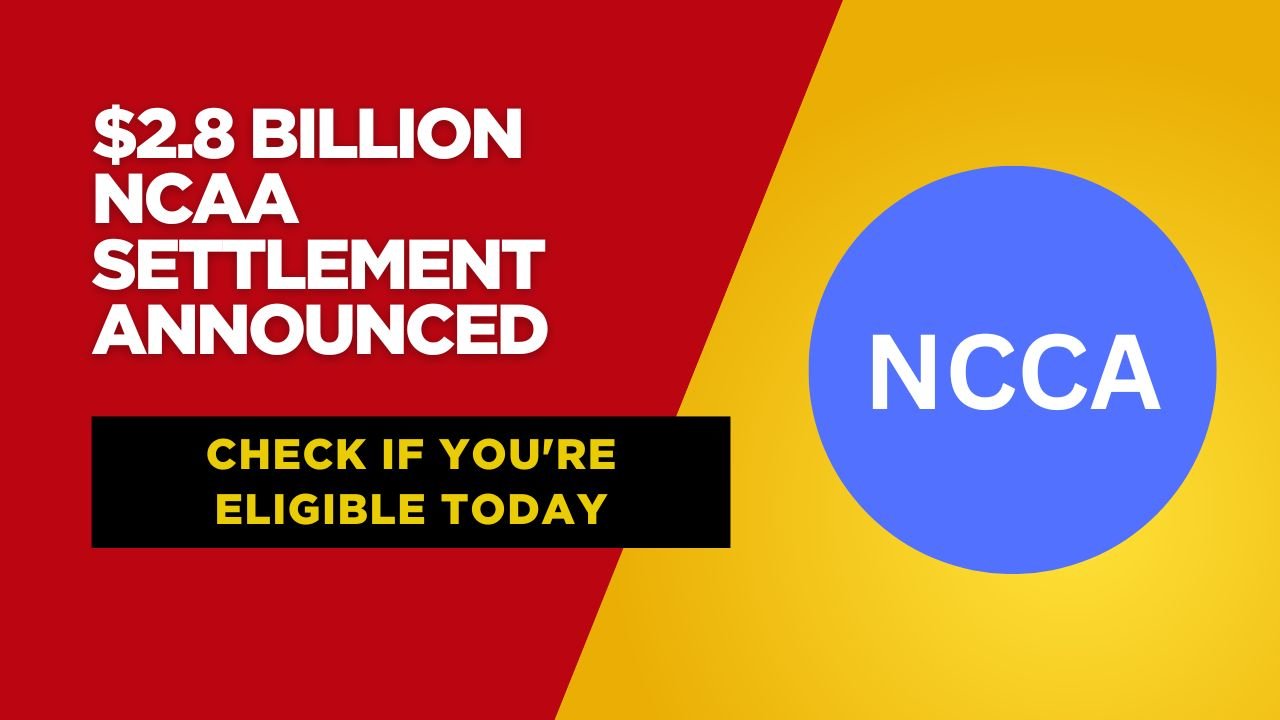NCAA Staffing Case: In an unprecedented ruling by the courts, the NCAA Settlement has agreed to compensate student-athletes with a whopping $2.8 billion for their long exploitation. Not only has this ruling changed the scene of college athletics, but it is also a major victory for athletes across the country.
This guide covers everything you need to know about who qualifies, how payment will actually be made, what this will mean for college athletics in the future, and how athletes can claim their part.
Overview of the $2.8 Billion NCAA Settlement
In 2025, the NCAA has entered into a $2.8 billion settlement agreement with its premier college athletic conferences to resolve the claims of former and current student-athletes. The settlement compensates former and current student-athletes for allegations that the NCAA violated antitrust law by withholding their rights to earn money through their labor and name, image, and likeness rights.
Key Facts:
| Detail | Information |
|---|---|
| Total Settlement | $2.8 Billion |
| Eligible Time Period | Athletes from 2016 to present (NIL rule era) |
| Type of Case | Antitrust Class Action |
| Court Jurisdiction | U.S. District Court, Northern District of California |
| Judge Overseeing Case | Judge Claudia Wilken |
Who Is Eligible for the Settlement?
The settlement is designed to compensate Division I athletes who participated in collegiate sports prior to July 1, 2021—when NIL rights began to be recognized.
Eligibility Criteria:
- Participated in a Division I athletic program.
- Competed between 2016 and July 1, 2021.
- Were affected by restrictions on receiving NIL compensation or other monetary benefits.
- Must not have previously opted out of the class-action lawsuit.
Eligible Conferences:
| Conference Name | Included in Settlement |
|---|---|
| ACC | Yes |
| Big Ten | Yes |
| SEC | Yes |
| Pac-12 | Yes |
| Big 12 | Yes |
| Other DI Schools (FBS) | Selectively |
Initially decided upon in the 1970s and 1980s, the payment structure will supervise the payout of the $2.8 billion settlement over a 10-year time span, with a sizable amount going for backpay to former athletes. The remaining funds will be directed towards creating revenue-sharing systems for current athletes.

Distribution Table:
| Category | Allocation Estimate |
|---|---|
| Backpay to Former Athletes | $2.78 Billion |
| Administrative Fees | $20 Million |
| Future Revenue Sharing Pool | Capped at $20M/year/school (starting 2025) |
Compensation Schedule:
- Delayed Pay: Initial disbursement of back payments in late 2025.
- 2026-2035: Continuous revenue sharing on participation and school agreements.
This settlement is a heavy seismic shift in the world of college sports in the U.S.
Key Consequence:
- Revenue Sharing Becomes the Norm: Athletes can take a share of school revenues.
- Bigger Monetary Incentives: Increase athlete retention and recruiting.
- Reconfiguration of University Budgets: More money moving from facilities to athlete salary.
- Redefinition of Amateurism: NCAA will no longer be able to say athletes are amateurs.
Revenue Sharing Cap:
| School Revenue | Annual Cap for Athletes (2025-26) |
|---|---|
| Up to $100M | $20M max |
| $100M+ | Subject to renegotiation |
How to Make a Claim With It
While waiting to hear if the final settlement is approved, qualified athletes can prepare by learning what documentation will be required.
- Claim process:
- Get Notification: Class members are notified through email or mail.
- File a Claim Form: Formulates proof of athletic participation details.
- Attach Documentation: Proof of participation (scholarship records, letters and more).
- Wait for Approval: Payments to begin with court approval.
Tips for Smooth Claim Process:
- Keep contact information updated with the former school.
- Save copies of scholarship agreements or participation letters.
- Watch out for updates from the court administrator or class counsel.
Legal Setting and Timeline
This class-action suit is the outgrowth of several cases, in particular House v. NCAA, which was filed in 2020. The key argument of the plaintiffs is that student-athletes were illegally denied NIL compensation and were subjected to wage-fixing.
Post not found.
Lawsuit Timeline:
| Year | Event |
|---|---|
| 2020 | House v. NCAA filed |
| 2021 | Supreme Court ruling in NCAA v. Alston supports athletes |
| 2022 | NIL rules implemented |
| 2024 | Settlement negotiations intensify |
| 2025 | $2.8B settlement proposed |
Expert Reactions
Discussions regarding the settlement have abounded across the sports world.
Supports Say:
It’s a long overdue justice to the athlete.
The colleges have profited from free labor for decades.
It would instigate a fair system.
Critics Say:
The financial obligation might affect the non-revenue sports.
Some universities might cut programs to support the payment of athletes.
Hence there might be new lawsuits or demands.
What Happens Next?
Court Approval Underway: The next hearing is expected in the mid-2025.
Reaching Athletes: Notice will be going out to class members.
Revenue Sharing Begins: For the 2025-26 academic year.
Continued Oversight: Court-appointed administrators will oversee payment organizing.
FAQS:
How much will each athlete get as his share?
It would depend on sport, years of participation, and individual impact. So, some athletes might have received just a few thousand dollars while others may have received significant more.
Do I need a lawyer to file a claim?
No, but you may consult one. Class counsel would actually help you process the claim at no cost.
Is this settlement final?
No, the federal court overseeing the case must grant final approval.
Is that future athletes affect by this?
Yes. Starting in 2025 revenue-sharing agreements will lead to annual compensation for athletes.
Will current athletes also qualify for backpay?
Yes, if they competed before July 1, 2021, and meet other criteria.

